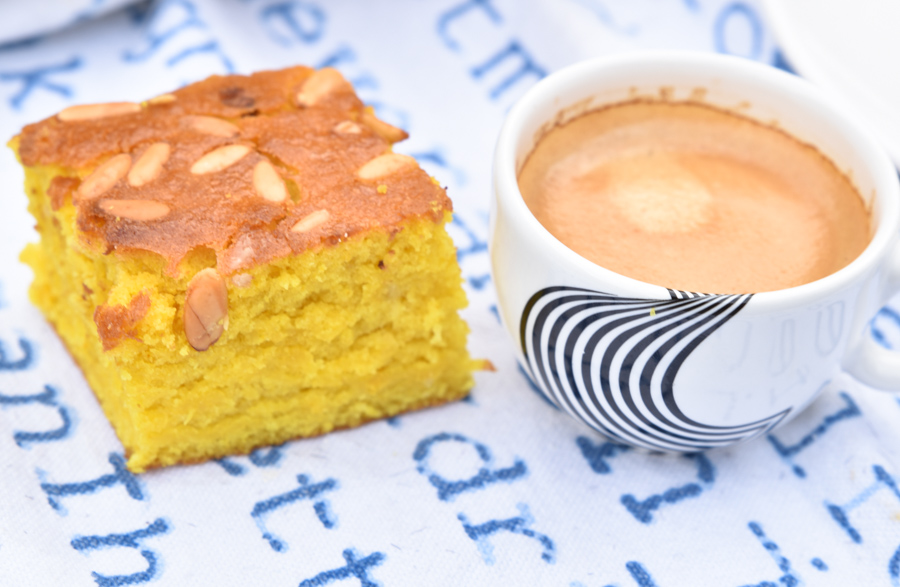
Sfouf, Lebanese Turmeric Cake
To say that sfouf is my favorite food of all time would be one of the least exaggerating things I’ve ever said. Because it’s true. I enjoy a lot of sweets, but this is the one that wraps up comfort and nostalgia for me in every bite— there’s nothing that screams childhood more than sfouf! This Lebanese yellow sheet cake was always a major part of any family gathering, ultimately, my favorite memories are tied to those afternoon gatherings at my granny’s house chatting, laughing and eating with my sisters and cousins. Granny or teta Roro as we used to call her, would put the sfouf bars in her vintage china plate patterned with Romeo and Juliette that she set up for special occasions with an extensive set including an assortment of serving dishes and teacups, she would branch out often with desserts such as rice pudding, meghli, namoura, mouhalabieh and other desserts she made most often. It just amazes me how much food is embedded into happy memories. I hope this sfouf recipe brings you and your loved ones the same joy each time you enjoy it.

Here is a step-by-step video to make the process more comprehensive and to show you exactly how to get the perfect Sfouf/Lebanese Turmeric Cake.
Sfouf, Lebanese Turmeric Cake (Video)
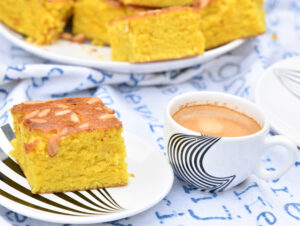
Any occasion is more celebratory with this yellow Lebanese sheet cake that is called sfouf, it is the kind typically brought to gatherings in Lebanon and served with a cup of coffee or tea, flavorful enough to serve plain.
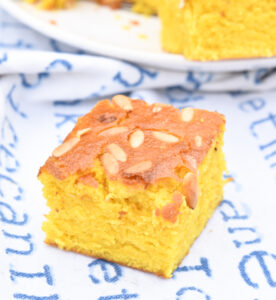
Ratio of flour to semolina!
One of my first arguments with my husband, thirty years ago, was about sfouf. “These are not the typical sfouf sold in sweet shops in Lebanon” he said, pointing disdainfully at the sfouf plate I made back then: “They should be a bit dense and should have a yellow color, rather than that orange striking interior.” Now there is always a debate here in sfouf making among folks in Lebanon about the ratio of flour to semolina! If your goal is to achieve a fluffy sfouf result, then you can go for equal amounts of flour and semolina, but to tell the truth, my husband is right, authentic sfouf should be tender but a bit on the dense side with a cakey firm texture, just like the ones we grew up eating in Beirut. You shouldn’t end up with a fluffy texture. Through trial and error, I came up with 2 favorite versions that I hold on since both works well. One appears in my cookbook, and the other I will be graciously sharing it with you in today’s post! It’s a one-bowl that comes together quickly, requires just few ingredients and takes less than an hour from start to finish! It’s also pretty foolproof to make as you mix together all the ingredients, pour the batter into a cake pan, and bake. I make it often, for fancy dinner parties or afternoon snacking, birthdays or brunches.
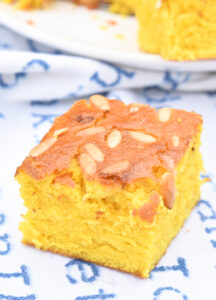
Grease your cake pan with tahini
Greasing your cake pan with tahini not only will prevent the sfouf from sticking when you bake, it also tastes good. Brush the tahini all over the surface of the pan, don’t let any part of the inside of the pan go ungreased. If tahini is not available, you can still grease with a piece of butter!
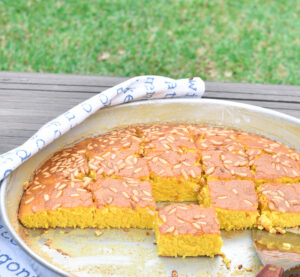
These ingredients make an appearance in sfouf
- All-purpose flour, suitable to create the tender and dense sfouf structure.
- Farina, it is a milled cereal grain, usually made from wheat germ and the inner parts of wheat kernels called the endosperm, if you can’t find farina, fine semolina would be great too.
- Turmeric, a terrific addition in terms of taste and color, and I don’t need to explain the health benefits of turmeric.
- Sugar, use granulated sugar.
- Oil, any neutral oil lie sunflower or canola oil.
- Butter, a knob of butter to add more flavor.
- Baking Powder: is the leavening agent that causes expansion of the batter, as you must have noticed it is an eggless cake.
- Milk the liquid ingredient that binds the batter together.
- Pine nuts or your favorite nuts like blanched almonds or cashews.
- Powdered Milk, it is the secret ingredient that has an amazing way of adding a terrific flavor to souf. The fat and lactose in milk help with tenderizing it making it softer, silkier yet denser and the crust gets more caramelization.
- Tahini, to grease the cake pan before adding the sfouf batter.
The secret ingredient:
Milk powder has an amazing way of adding a terrific flavor to souf. The fat and lactose in milk help with tenderizing it making it softer, silkier yet denser and the crust gets more caramelization.
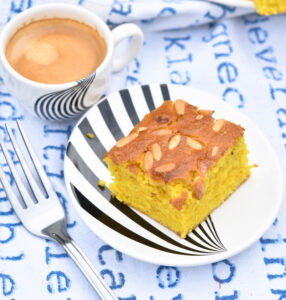
How to vegenize sfouf?
Sfouf can easily be tweaked to suit people following a vegan diet. It is common practice in Lebanon to vegenize sfouf, especially during lent, and since it is an eggless cake by nature, all you have to do is to eliminate the butter and add more canola or sunflower oil. As for the milk, there are many plant-based alternatives that work well. I have tested once the almond milk, and I would say it was quite satisfying!
Tips and Tricks
- Try to put your hands on the freshest turmeric you can find. It is the strong supporting player in sfouf, if not the main attraction.
- I would recommend an aluminum baking sheet to make sfouf since it conducts heat more efficiently, and by that it will help in preventing an uncooked center nor a burned bottom.
- You get the most tender sfouf when you beat the batter the least.
- Use an offset spatula to make sure your sfouf batter is spread in an even layer.
- Randomly, dress the sfouf before baking with pine nuts / shaved almonds/ cashew nuts or even walnuts. They add character to sfouf. If nuts are not a favorite of yours, sesame seeds are another option, or simply leave them out!
- Keep an eye on the sfouf sheet while it’s baking, you should end up with a beautiful golden-brown color, and a tester that comes out clean when you poke it deep into the center.
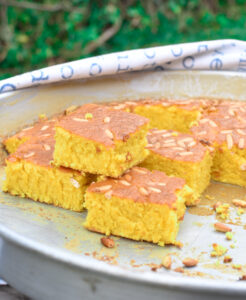
Sfouf has tons of fans thanks to its cakey texture, nutty taste and turmeric flavor. It’s also globaly loved because it’s just such an easy thing to make, yes, a huge payoff for very little effort. It is great for impromptu gatherings, afternoon tea, morning accompaniment to coffee and last, but not least, enjoyed by your family throughout the holiday season,with a video tutorial above!
Storage: Store, covered with cling film, at room temperature for up to 4 days.
- Author:Hadia Zebib Khanafer,
- Prep Time: 10 minutes
- Baking time: 20 to 25 minutes
- Serving: Makes 20 pieces
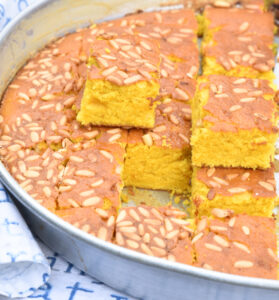
Ingredients:
- 2 2/3 cups all-purpose flour
- 1/3 cup farina or fine semolina
- 2 teaspoons baking powder
- 1 3/4 cup granulated sugar
- ½ cup oil
- ¼ cup butter, (eliminate for a vegan option, add more oil)
- 1 leveled tablespoon turmeric powder
- 1 ¼ cups milk, or (almond milk for a vegan option)
- 2 tablespoons full cream powdered milk, optional but highly recommended, (eliminate for vegans)
- 4 tablespoons tahini, to grease the baking sheet
- 1/3 cup pine nuts or your favorite nuts
Directions:
- Preheat oven to 400°F / 200°C. Place a rack in the center.
- In a large bowl mix together the flour, farina, turmeric powder, milk powder (if used) and baking powder.
- In another bowl dissolve the sugar in milk, add the oil and melted butter.
- Add the dry ingredients (flour semolina mixture) to the wet ones. Stir well to obtain a yellow batter.
- Grease a round 12 inches/ 30 cm baking pan with tahini.
- Pour the sfouf batter to the baking sheet and use an offset spatula to make sure your sfouf batter is spread in an even layer.
- Scatter the pine nuts randomly over the sfouf batter.
- Bake to a golden color about 20 to 25minutes. Keep an eye on your oven.
- Remove from the oven, allow to cool down completely, divide into medium squares or diamond shapes. With a video tutorial above!
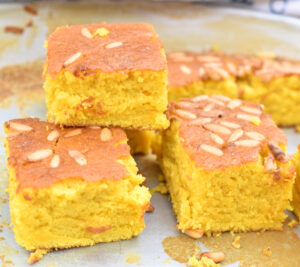
Thank you to all the readers who purchased “Hadia, Lebanese Style Recipes”. If you have a minute to spare, please rate and review the book on Amazon. We would like to know what you think! Here is the link to AMAZON


If you make "Sfouf, Lebanese Turmeric Cake", leave a comment below, or share your pictures on Facebook! I would love to see your creations!! Hashtag, #Hadia’s lebanese Cuisine
Subscribe to Our Newsletter
Instructions
No Steps Found !
- Course : BREAKFAST
- Recipe Type : BreakFast, BREAKFAST, DESSERTS, DESSERTS, LEBANESE RECIPES, Lebanese Style Recipes, Snacks, VEGAN RECIPES
- Ingredient : turmeric
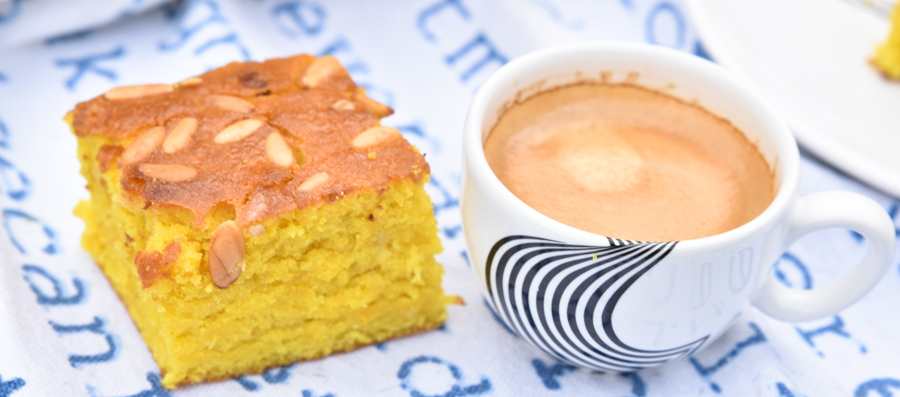
6 Responses to Sfouf, Lebanese Turmeric Cake
Leave a Reply Click here to cancel reply.
About Chef
Hadia Zebib
I am Hadia, the face behind Hadia’s Lebanese Cuisine. I grew up in Beirut Lebanon and I currently reside in Kinshasa, Congo with my husband and my three adorable sons, ...
Read more about this chef..

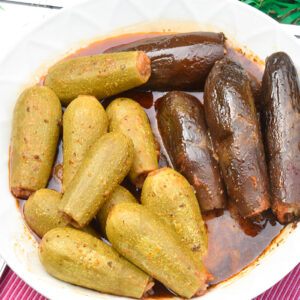
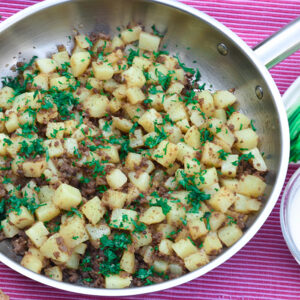
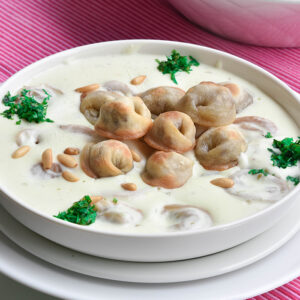
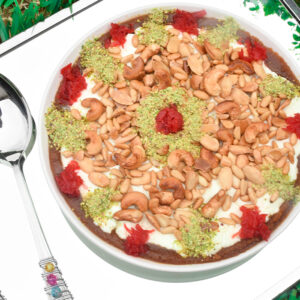

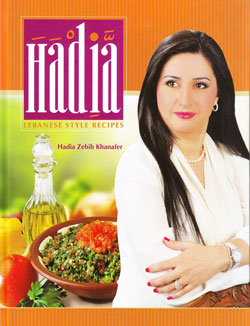
There appears to be a typo for the amount of sugar in the recipe. Is it 1 3/4 cup? That seems a lot?
Hi Jennifer, it is correct 1 +3/4 cup sugar, and the end result is moderately sweet.
Thank you for the excellent recipe, very easy to make. I have been wanting to make your sfouf ever since you post it. I thought it was impossible to get the bakery style sfouf at home, but your recipe changed that, my family enjoyed so much. Thank you Hadia.
That’s great to hear Sarah, it is a great recipe, I am happy that you tried and loved, xoxo
Is it one table spoon of turmeric powder. Can I make it one tea spoon. Wont it over power the taste.
Yes, it is 1 tablespoon turmeric powder. That’s how I tested the recipe, and one tablespoon is is not so strong!